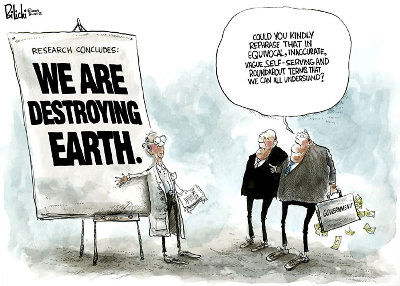The Unspoken Problem - World Population
Population Pressure
The global population, now about 7.3 billion people has doubled twice in my lifetime. In the last 150 years the population has doubled seven times, but the amount of ![]() greenhouse gases we are producing has increased fifty fold, as our production technologies changed. These extra people live and have developed farms or cities on the land that was once the preserve of nature. In the process the species that lived in that space were either forced out or died out. The population of many non-human species has fallen catastrophically over the same period. The extinction rate for existing species is very high, and that is caused by the expansion of human settlements and resource use.
greenhouse gases we are producing has increased fifty fold, as our production technologies changed. These extra people live and have developed farms or cities on the land that was once the preserve of nature. In the process the species that lived in that space were either forced out or died out. The population of many non-human species has fallen catastrophically over the same period. The extinction rate for existing species is very high, and that is caused by the expansion of human settlements and resource use.
Family Planning
Open Future™ has met very few people who are willing to look honestly at this problem. The world might be able to sustain a population of 10 billion people if 9.5 billion are very poor and half a billion are modestly rich, but that's not the sort of society any of us want. We want to eliminate extreme poverty, and to a large extent to eliminate poverty. Everyone regardless of which country they come from should have a fair share of the resources of the world. We should share similar standards of living, similar uses of the Earth's resources and be able to live a life that is full and useful and meaningful. If we are all to live like Americans have lived in the last 20 years the world can't sustain a very big population in a sustainable way. Probably less than a billion people.
China as a Model
Open Future™ guesses that given a choice people will choose to have a larger maximum population than that and to live with a lot less stuff. We expect that China will be the first country to find a model that works, if only because the pressure is greatest in China. In many ways what's happening in China is the future of the world. Fortunately lots of good things are happening in China, despite the many problems.
Family Planning
At least 200 million women in developing countries ![]() have unmet needs regarding birth control. Open Future recommends that we engage in active programmes to develop gender equality for women and to make child-birth a real choice women can make. There is lots of evidence that women even in very poor countries will choose a maintenance level of reproduction if given an effective choice. That would be desirable and would give us more time to solve some other problems.
have unmet needs regarding birth control. Open Future recommends that we engage in active programmes to develop gender equality for women and to make child-birth a real choice women can make. There is lots of evidence that women even in very poor countries will choose a maintenance level of reproduction if given an effective choice. That would be desirable and would give us more time to solve some other problems.
However, I expect that religious and political forces will work against that idea, and so we'll have ongoing population growth and at some future time decided by nature, a catastrophic collapse of human population will occur. There are many reports from around the world of population collapse in animal populations. Honey bees and bumble bees are one concern, monarch butterflies are another.
World population: Too many people or too few?
(5 minutes)
Published by: TRT World - July 2023
Population Decline
 [From Wikipedia] "A number of nations today are facing long term population decline, stretching from North Asia (Japan through to Eastern Europe through Russia including Kazakhstan, Ukraine, Belarus, Moldova, Estonia, Latvia, Lithuania, Bulgaria, Georgia, Armenia, Bosnia, Croatia, Slovenia, Germany, Hungary, and now Italy. Countries rapidly approaching long term population declines (but currently still growing, albeit slowly) include Greece, Spain, Cuba, Uruguay, Denmark, Finland, Austria and Lesotho.
[From Wikipedia] "A number of nations today are facing long term population decline, stretching from North Asia (Japan through to Eastern Europe through Russia including Kazakhstan, Ukraine, Belarus, Moldova, Estonia, Latvia, Lithuania, Bulgaria, Georgia, Armenia, Bosnia, Croatia, Slovenia, Germany, Hungary, and now Italy. Countries rapidly approaching long term population declines (but currently still growing, albeit slowly) include Greece, Spain, Cuba, Uruguay, Denmark, Finland, Austria and Lesotho.
Open Future™ expects a population decline on a massive scale sometime this century. We expect that the real sustainable population of the Earth is between one billion and two billion. We expect to be forced to that level before 2100. In the next 90 years. If we create a smooth graph for that what must that mean? Famine, wars, civil strife and some new infectious disease, are expected to take a toll.
Can we Get to Two Billion?
I've no expertise in this but here's my estimate.
The birth rate is expected to be about 20 per 1000 population. The death rate is 10 per thousand population.
If I run that on a spread sheet I get roughly the population predicted by the UN for 2025, and for 2040.
Albert Bartlett - Blind Spot
Dr Albert Bartlett (5 minutes)
Published by: OilCrash - December 2008
Whatever the measures of greed, wishful thinking, neglect or ignorance, we have put ourselves at a crossroad which offers two paths, both with dire consequences.If we continue to burn fossil fuels we will choke the life out of the planet and if we don't our way of life will collapse.
"Blind Spot is a fascinating documentary, it draws on some of the most impressive scientific minds to warn us about the dangers of our dependence on oil and educate us about our role in saving the earth and the lives of our children. I was transfixed by it."
-Howard Zinn
If we lived in a rational world, inhabited by rational human beings, viewing Blind Spot would be a mandatory prerequisite to taking any federal oath of office in the coming year. Were that to happen, there might be hope that the USA would resume world leadership and our renewed influence would be used to redirect ourselves and the world away from the unsustainable path upon which we plummeted along throughout the 20th century, mistakenly regarding the adventure as unmitigated progress.
-William Catton Jr., author of Overshoot
World Population
(6 minutes)
Published by:Population Education - March 2015
Now, if we take strong action to reduce the birth rate. Say we cut it in half. The natural death rate remains the same. To reach a population of about 2 billion by 2100, how many additional people will "disasters take out"? Reducing the birth rate by 50% does a great deal on it's own. For a number of years the deaths will exceed the births by an increasing number. Once we get out 30 or 40 years it's hard to tell what will happen, but getting to 2 billion is not impossible. It requires a high death rate, but not more than double the normal death rate. It's very unpleasant, but I expect that sort of thing to happen and the human race will survive.
Decline in Animal Populations
We are already seeing this sort of population collapse in animal populations. I expect our turn is coming, and we should welcome it, because a smaller population is going to make sustainability possible. That means humanity survives. ![]() A Troubling Decline in the Caribou Herds of the Arctic. From Africa we hear about
A Troubling Decline in the Caribou Herds of the Arctic. From Africa we hear about ![]() monkey nests declining in numbers, about the
monkey nests declining in numbers, about the ![]() loss of elephant herds. From India we have the saving from extinction of the wild tiger, and
loss of elephant herds. From India we have the saving from extinction of the wild tiger, and ![]() huge population declines for vultures. In the oceans we hear that
huge population declines for vultures. In the oceans we hear that ![]() big fish are all endangered but so are
big fish are all endangered but so are ![]() the small fish. Among the most
the small fish. Among the most ![]() endangered species are amphibians which seem to suffer form pesticides in our waterways. And we hear that the number of fish in our freshwater rivers is only a tiny fraction of what once existed.
endangered species are amphibians which seem to suffer form pesticides in our waterways. And we hear that the number of fish in our freshwater rivers is only a tiny fraction of what once existed.
Overshoot Homepage (Desktop)
